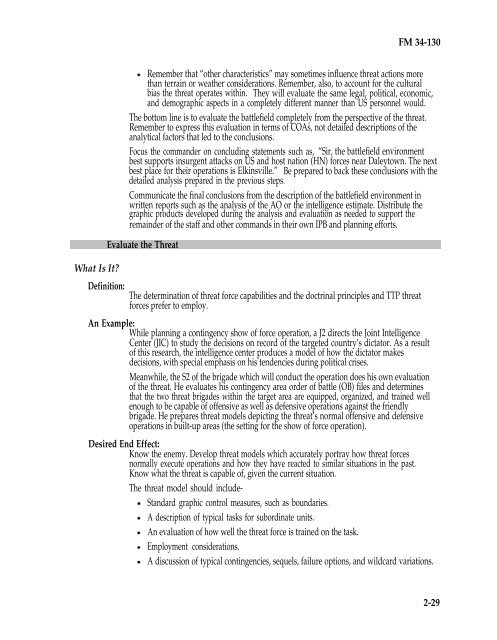Intelligence Preparation of the Battlefield - Federation of American ...
Intelligence Preparation of the Battlefield - Federation of American ...
Intelligence Preparation of the Battlefield - Federation of American ...
Create successful ePaper yourself
Turn your PDF publications into a flip-book with our unique Google optimized e-Paper software.
What Is It?<br />
FM 34-130<br />
Remember that “o<strong>the</strong>r characteristics” may sometimes influence threat actions more<br />
than terrain or wea<strong>the</strong>r considerations. Remember, also, to account for <strong>the</strong> cultural<br />
bias <strong>the</strong> threat operates within. They will evaluate <strong>the</strong> same legal, political, economic,<br />
and demographic aspects in a completely different manner than US personnel would.<br />
The bottom line is to evaluate <strong>the</strong> battlefield completely from <strong>the</strong> perspective <strong>of</strong> <strong>the</strong> threat.<br />
Remember to express this evaluation in terms <strong>of</strong> COAs, not detailed descriptions <strong>of</strong> <strong>the</strong><br />
analytical factors that led to <strong>the</strong> conclusions.<br />
Focus <strong>the</strong> commander on concluding statements such as, “Sir, <strong>the</strong> battlefield environment<br />
best supports insurgent attacks on US and host nation (HN) forces near Daleytown. The next<br />
best place for <strong>the</strong>ir operations is Elkinsville.” Be prepared to back <strong>the</strong>se conclusions with <strong>the</strong><br />
detailed analysis prepared in <strong>the</strong> previous steps.<br />
Communicate <strong>the</strong> final conclusions from <strong>the</strong> description <strong>of</strong> <strong>the</strong> battlefield environment in<br />
written reports such as <strong>the</strong> analysis <strong>of</strong> <strong>the</strong> AO or <strong>the</strong> intelligence estimate. Distribute <strong>the</strong><br />
graphic products developed during <strong>the</strong> analysis and evaluation as needed to support <strong>the</strong><br />
remainder <strong>of</strong> <strong>the</strong> staff and o<strong>the</strong>r commands in <strong>the</strong>ir own IPB and planning efforts.<br />
Evaluate <strong>the</strong> Threat<br />
Definition: The determination <strong>of</strong> threat force capabilities and <strong>the</strong> doctrinal principles and TTP threat<br />
forces prefer to employ.<br />
An Example: While planning a contingency show <strong>of</strong> force operation, a J2 directs <strong>the</strong> Joint <strong>Intelligence</strong><br />
Center (JIC) to study <strong>the</strong> decisions on record <strong>of</strong> <strong>the</strong> targeted country’s dictator. As a result<br />
<strong>of</strong> this research, <strong>the</strong> intelligence center produces a model <strong>of</strong> how <strong>the</strong> dictator makes<br />
decisions, with special emphasis on his tendencies during political crises.<br />
Meanwhile, <strong>the</strong> S2 <strong>of</strong> <strong>the</strong> brigade which will conduct <strong>the</strong> operation does his own evaluation<br />
<strong>of</strong> <strong>the</strong> threat. He evaluates his contingency area order <strong>of</strong> battle (OB) files and determines<br />
that <strong>the</strong> two threat brigades within <strong>the</strong> target area are equipped, organized, and trained well<br />
enough to be capable <strong>of</strong> <strong>of</strong>fensive as well as defensive operations against <strong>the</strong> friendly<br />
brigade. He prepares threat models depicting <strong>the</strong> threat’s normal <strong>of</strong>fensive and defensive<br />
operations in built-up areas (<strong>the</strong> setting for <strong>the</strong> show <strong>of</strong> force operation).<br />
Desired End Effect:<br />
Know <strong>the</strong> enemy. Develop threat models which accurately portray how threat forces<br />
normally execute operations and how <strong>the</strong>y have reacted to similar situations in <strong>the</strong> past.<br />
Know what <strong>the</strong> threat is capable <strong>of</strong>, given <strong>the</strong> current situation.<br />
The threat model should include-<br />
Standard graphic control measures, such as boundaries.<br />
A description <strong>of</strong> typical tasks for subordinate units.<br />
An evaluation <strong>of</strong> how well <strong>the</strong> threat force is trained on <strong>the</strong> task.<br />
Employment considerations.<br />
A discussion <strong>of</strong> typical contingencies, sequels, failure options, and wildcard variations.<br />
2-29
















